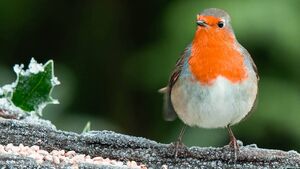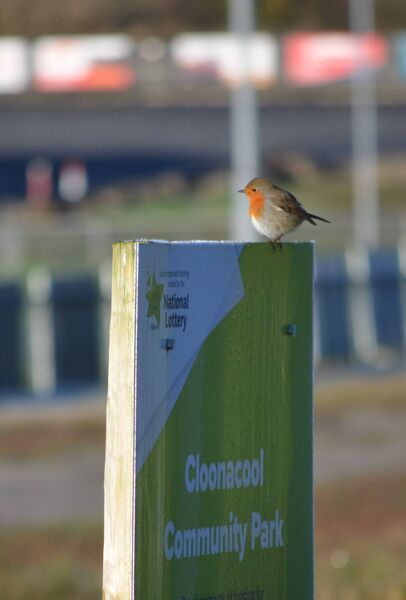The robin holds a special place in our hearts

This stunning photograph of a robin in winter was taken by Gerry Kavanagh, Galway, and was one of the winners in the Irish Examiner's Readers' Photography Competition 2023.
Few sights conjure up as much sympathy as the forlorn robin skipping about in the middle of winter trying to get enough to eat. If we were to have a bird or a natural symbol for our Ox Mountain region, it could be well be the humble robin.
The reality of the robin (an spideog, as he is known in Irish - unknown origin but may derive from spid meaning “energy”), is that he feels little need for our sympathy. The robin is a fiercely independent little fellow that has evolved all sorts of survival techniques. While many of us see him as the quintessential symbol of peace and devotion, for the most part, he is a bullish and self-centred character. By the way, I will refer to the robin as a ‘he’ throughout this piece for reasons that will become clear as we go on.
Birdwatch Ireland takes up the story and gives the basic facts and figures on the little bird that is seen in every garden and field in Ireland.
One of the most notable things about the robin is his territorial nature. This is where his bullish streak comes in. He has his patch and that’s it! It is also believed that the male robin sees all robins as male and so not even a female robin, interested in being buried with his people, gets a chance to state her intentions. It is only at the very last second during the breeding season, that the female convinces Mr Robin that there is more to life than filling his belly or fighting with the neighbours. He finally takes the hint and, for one unguarded moment, joins the mating game.
Each year, there are over two million pairs of robins that breed across the Republic of Ireland. Their nests are usually well-concealed in a bank, under ivy or in a cavity in tree or wall. Sometimes the robin chooses an unusual location such as a hat or jacket hanging in a turf shed, further adding to his endearment.

in (July 2017) had this to say about the robin:
The robin is reputed to have stood at the foot of the cross when Jesus died, his breast stained forever red by a drop of the Saviour’s blood. It is a wholesome construct but why then do we not revere the little fellow as an Easter bird rather than a Christmas bird – a seasonal slot he can well and truly call his own. Maybe it is his forlorn figure, perched on a Christmas snow branch, that endears us so much. However, Liam O Dochartaigh in his article, ( , December 22, 2010), gives several explanations for the Christmas connection. I am not sure Charles Darwin would agree with any of them but here goes.
An entirely different tradition associates the robin's red breast with the Nativity. A correspondent in the Midlands told of the way the robin got its distinctive red breast as a result of its attempts to fan the embers of a dying fire in the stable in Bethlehem. The fire was revived and the Holy Family had warmth but the robin's breast was singed red and remains so ever since.
The real facts about the robin’s red breast are that it communicates vital information, a bit like a noticeboard. The red feathers on the breast area convey information about sex, age, or other important robin information.
I have a personal connection with the robin. Many people have the same connection and while the relationship is easily explained, the connection is often a mystery. My father died in 2008 and for a few years afterwards, I could not connect with him. While we had a good relationship in life, once he died, it was like that connection with him had vanished without a trace. I waited and waited but despite my waiting, there was no sign of my dad. I had no idea he was around me in any form and I was disappointed that his spirit had seemingly vanished.
About four years later, I had a dream. It was a dream of a robin, a repeat reel of a robin taking off in flight. Even as I write, I still see the image clearly. I awoke knowing it was a message from my father. I felt the message was that he was gone but that there were signs of him everywhere, I just needed to recognise them. I decided the robin was that sign, a reminder to keep an eye out. Now, I see the robin almost every day and when I see him, I am reminded of my dad in a most reassuring way.
I later told the story to my mother and she informed me that my dad had the same connection to the robin. She remembered him telling her at one time, when had spent the whole day moving a load of turf into the shed, that a robin had come and spent the day in his company. Later that day, he got word that his sister had died that morning. He immediately connected the robin’s company to the loss. It was a reassurance to him, a comfort.
So, what is it about the robin, our robin? How come, of all the little birds, he manages to find his way into our hearts? Maybe it is his diminutive size or his ability to survive the austere winter months. Maybe it is his song; hearty and clear and unmistakable. Maybe it is his unique colouring; that red breast that conjures up so many imaginings as to how it came to be. Or, maybe we see him as a delicate innocent, a vulnerable creature deserving of all our praise and respect.
My own thought is that the robin is simply… special. Maybe he has a connection to the divine or the spirit word. Maybe he knows something we don’t. If I were you, I’d keep an eye out for the robin from now on and see what wisdom he has to impart, and what directions he may have for you. He just might surprise you.






